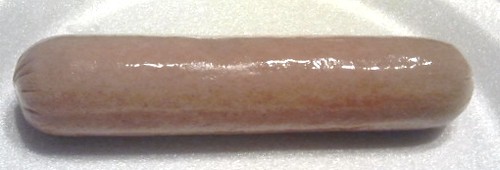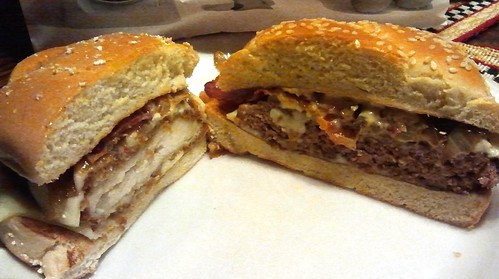 Late last week, I got a heads-up from Steve Wood, who writes Connecticut Museum Quest, a top-notch Connecticut blog that is about so much more than just museums. He alerted me to a new product at Ocean State Job Lot: Farmer's Pride Snack Bologna (which just so happened to be featured in OSJL's "internet coupon" selection.)
Late last week, I got a heads-up from Steve Wood, who writes Connecticut Museum Quest, a top-notch Connecticut blog that is about so much more than just museums. He alerted me to a new product at Ocean State Job Lot: Farmer's Pride Snack Bologna (which just so happened to be featured in OSJL's "internet coupon" selection.)Holy shit, pickled bologna! How could I resist?
Lynnafred found the jars at our local Ocean State. She picked one up - it was the size of a largish peanut butter jar - and peered at the "bologna" within: they were in the form of huge, fat Vienna sausages (and according to the ingredient panel, they're composed of pretty much the same stuff.) The jars were plastic and sealed with soft plastic lids, and as Lynnafred looked through the brine at the bologna she said, "Eww. These are grey. Are they supposed to look like that?" After looking at a dozen other jars, and finding all of them containing somewhat greyish weiners sealed within, we concluded that the answer was probably Yes, they are supposed to look like that. The coupon said that there was a limit of 12 jars per family, but we curbed our enthusiasm and held ourselves to the purchase of a single jar which, at $1.20, seemed to be a fair price.
Let me start the actual review by saying that I can not believe that Farmer's Pride pickled bologna is a regularly-produced consumer good. Every single component of this product screams "DISPOSE OF CHEAP SHIT!!" The jars are flimsy plastic, the lids seem to be made of the same quality plastic as imported dollar-store toys from China, the labels look like they were run off on a laser printer. Most of the jars at the store had sticky label residue clinging to the non-labeled areas, telling me that these snacks were probably rejected by the company which originally contracted them, leading the manufacturer to hastily peel the original label and rebrand them for the "remainder market" (i.e. dollar stores and job lot joints like OSJL.) And then, of course, there is the actual bologna itself:
 That is one nasty-ass piece of tubesteak right there. Check out the gradations of coloring, from a kind of brownish-grey at the ends to rather pinkish in the middle. I swear I used no filtering or image manipulation to change those colors - that is exactly how they come out of the jar. Unfortunately, I wasn't able to capture the true beauty of the grey lines that run from tip to tip on the wieners, especially where the meat was in contact with the sides of the jar. These things are truly ghastly to look at.
That is one nasty-ass piece of tubesteak right there. Check out the gradations of coloring, from a kind of brownish-grey at the ends to rather pinkish in the middle. I swear I used no filtering or image manipulation to change those colors - that is exactly how they come out of the jar. Unfortunately, I wasn't able to capture the true beauty of the grey lines that run from tip to tip on the wieners, especially where the meat was in contact with the sides of the jar. These things are truly ghastly to look at. At least when we cut into the wiener we found that the grey color doesn't go all the way through - once you get a little way into the surface, everything kind of turns pink again. I guess that means that they're okay to eat. Honestly, eyeballs are all we have to go by for safety, because there are absolutely no olfactory cues here. No scent of spices, no aroma of meat - nothing at all except the pungency of strong vinegar stabbing at our nostrils like fleets of aromatic daggers. The manufacturer (Monogram Meat Snacks LLC, USDA EST 795) could not possibly have made the brine any more unpleasantly sharp.
At least when we cut into the wiener we found that the grey color doesn't go all the way through - once you get a little way into the surface, everything kind of turns pink again. I guess that means that they're okay to eat. Honestly, eyeballs are all we have to go by for safety, because there are absolutely no olfactory cues here. No scent of spices, no aroma of meat - nothing at all except the pungency of strong vinegar stabbing at our nostrils like fleets of aromatic daggers. The manufacturer (Monogram Meat Snacks LLC, USDA EST 795) could not possibly have made the brine any more unpleasantly sharp.And the wieners are just as unpleasant to eat as they are to look at. The texture is firm and smooth, but there is little flavor beyond the powerful vinegar brine, which is so acidic that it actually produces a burning sensation in the mouth and throat. And - worst of all to me - the meat leaves a disgusting tallowy film coating the mouth and tongue. These things are grossly misnamed - they should be called "Farmer's Shame."
 As with so many other oddball snacks we've tried over the years, Farmer's Pride Snack Bologna proved to be pretty popular with the dogs, though I didn't dare give them all they wanted due to the acidity of the pickle (the last thing I want to do is spend an afternoon scrubbing dog puke out of the dining room rug.)
As with so many other oddball snacks we've tried over the years, Farmer's Pride Snack Bologna proved to be pretty popular with the dogs, though I didn't dare give them all they wanted due to the acidity of the pickle (the last thing I want to do is spend an afternoon scrubbing dog puke out of the dining room rug.)So there you have it. Cheap, shitty, only marginally edible, and obviously close to the end of its shelf life - Look for 'em at a dollar store near you - and pass them up in favor of almost anything else you find.
.

 The pale- and incredibly foul-looking cylinders of evil pictured above are the contents of a can of Senora Verde Beef Tamales, directly as emptied onto a paper plate. Some of them retained their paper sleeves as the can was tipped, others slipped from them like vile giant larvae shedding their outgrown skin. They were supposedly packed in "sauce," but that proved to be merely a watery tomato-flavored bile with a thick film of bright red grease floating on top. The "sauce" was easily disposed of, but globs of the grease stuck sort of randomly to everything else (including the plate, my fingers, and the walls of the microwave when I heated up this mess at work.)
The pale- and incredibly foul-looking cylinders of evil pictured above are the contents of a can of Senora Verde Beef Tamales, directly as emptied onto a paper plate. Some of them retained their paper sleeves as the can was tipped, others slipped from them like vile giant larvae shedding their outgrown skin. They were supposedly packed in "sauce," but that proved to be merely a watery tomato-flavored bile with a thick film of bright red grease floating on top. The "sauce" was easily disposed of, but globs of the grease stuck sort of randomly to everything else (including the plate, my fingers, and the walls of the microwave when I heated up this mess at work.) Single-serve frozen lasagna is one of my favorite lunches, and I'm always looking for new brands to try. So naturally, I grabbed a couple of boxes of Mendelsohn's Lasagna when I found it at The Barn in Greenfield MA.
Single-serve frozen lasagna is one of my favorite lunches, and I'm always looking for new brands to try. So naturally, I grabbed a couple of boxes of Mendelsohn's Lasagna when I found it at The Barn in Greenfield MA.
 My only previous experience with turtle soup was the poem in Lewis Carroll's Alice in Wonderland:
My only previous experience with turtle soup was the poem in Lewis Carroll's Alice in Wonderland:

 Medical advances have led to the longest life expectancy ever, but U.S. baby boomers have higher rates of chronic disease, more disability and lower self-rated health than did their parents at a comparable age.
Medical advances have led to the longest life expectancy ever, but U.S. baby boomers have higher rates of chronic disease, more disability and lower self-rated health than did their parents at a comparable age. The study, published as a research letter Feb. 4 in JAMA Internal Medicine, compared data on people aged 46 to 64 in two time periods -- from 1988 to 1994 for the older generation, and from 2007 to 2010 for the baby boomers.
The study, published as a research letter Feb. 4 in JAMA Internal Medicine, compared data on people aged 46 to 64 in two time periods -- from 1988 to 1994 for the older generation, and from 2007 to 2010 for the baby boomers. There was one area of good news, however. Boomers have lower rates of heart attack and emphysema, and are less likely to smoke cigarettes, the study reported. King noted that the reduction in smoking -- from 28 percent of the population to 21 percent -- shows the value of conducting a concerted public health campaign. He said the nation needs to focus the same amount of effort now on obesity to discover truly effective solutions.
There was one area of good news, however. Boomers have lower rates of heart attack and emphysema, and are less likely to smoke cigarettes, the study reported. King noted that the reduction in smoking -- from 28 percent of the population to 21 percent -- shows the value of conducting a concerted public health campaign. He said the nation needs to focus the same amount of effort now on obesity to discover truly effective solutions. The baby boomer generation had a higher percentage of people with high blood pressure, high cholesterol, diabetes and obesity than did their parents' generation.
The baby boomer generation had a higher percentage of people with high blood pressure, high cholesterol, diabetes and obesity than did their parents' generation.
 Do boomers rely too much on medications to solve their health issues? "I'm concerned that has a great deal to do with the problem," said King. "The drugs are supposed to be used in addition to a healthy lifestyle, not instead of it."
Do boomers rely too much on medications to solve their health issues? "I'm concerned that has a great deal to do with the problem," said King. "The drugs are supposed to be used in addition to a healthy lifestyle, not instead of it." 
 Three major clinical trials are starting this year, all looking at prevention in some way, Doraiswamy said. Two are testing drug treatment for people with gene mutations that cause inherited, early-onset Alzheimer's; the other involves older adults who have no dementia symptoms but do have amyloid deposits in their brains.
Three major clinical trials are starting this year, all looking at prevention in some way, Doraiswamy said. Two are testing drug treatment for people with gene mutations that cause inherited, early-onset Alzheimer's; the other involves older adults who have no dementia symptoms but do have amyloid deposits in their brains. It's thought that the brain damage in Alzheimer's begins a decade or more before symptoms emerge. There's also some evidence that the same risk factors for heart disease -- such as high blood pressure and diabetes -- might also be linked to Alzheimer's risk.
It's thought that the brain damage in Alzheimer's begins a decade or more before symptoms emerge. There's also some evidence that the same risk factors for heart disease -- such as high blood pressure and diabetes -- might also be linked to Alzheimer's risk. According to the Alzheimer's Association, the United States spent about $200 billion in direct treatment costs for Alzheimer's and other forms of dementia in 2012. If no progress is made, that figure will top $1 trillion in 2050.
According to the Alzheimer's Association, the United States spent about $200 billion in direct treatment costs for Alzheimer's and other forms of dementia in 2012. If no progress is made, that figure will top $1 trillion in 2050. In children and young adults, this brain sugar shortage due to faulty sugar/hormone shuttles manifests itself as epilepsy. In midlife, it shows up as hot flashes. In old age, it appears as Alzheimer's. These are signs of carb super-sensitivity that are going ignored by much of the populace--the kids may be getting the most beneficial treatment of all the cases of carb super-sensitivty.
In children and young adults, this brain sugar shortage due to faulty sugar/hormone shuttles manifests itself as epilepsy. In midlife, it shows up as hot flashes. In old age, it appears as Alzheimer's. These are signs of carb super-sensitivity that are going ignored by much of the populace--the kids may be getting the most beneficial treatment of all the cases of carb super-sensitivty. Why NOT administer coconut oil? It would put large drug companies out of business, as well as group homes and institutions devoted to Alzheimer's patients. Whoever thought so many people would be in such jeopardy from a coconut?
Why NOT administer coconut oil? It would put large drug companies out of business, as well as group homes and institutions devoted to Alzheimer's patients. Whoever thought so many people would be in such jeopardy from a coconut?
 "For people with celiac disease, everyday foods such as bread, pizza crust and muffins are potential enemies. But scientists anticipate that some day a simple pill could help prevent the digestive upsets caused by ingesting the gluten in wheat, rye or barley products.
"For people with celiac disease, everyday foods such as bread, pizza crust and muffins are potential enemies. But scientists anticipate that some day a simple pill could help prevent the digestive upsets caused by ingesting the gluten in wheat, rye or barley products. Ideally, the team could develop the enzyme into a food additive such as the gas remedies Beano or Gas-X and offer it without a prescription, said lead study author Justin Siegel, assistant professor of chemistry and biochemistry at the University of California, Davis. But this could take a few years to develop. If the researchers opt to make a prescription drug, the process of clinical trials and obtaining U.S. Food and Drug Administration approval could take a decade or more, he said.
Ideally, the team could develop the enzyme into a food additive such as the gas remedies Beano or Gas-X and offer it without a prescription, said lead study author Justin Siegel, assistant professor of chemistry and biochemistry at the University of California, Davis. But this could take a few years to develop. If the researchers opt to make a prescription drug, the process of clinical trials and obtaining U.S. Food and Drug Administration approval could take a decade or more, he said. How effective might the enzyme be? "For some people, even flour in the air makes them stop breathing. Some are very sensitive, and in some it just upsets their stomach a little," Siegel said. "For those who are hypersensitive, this probably is not going to solve the problem, but it would allow them to go to dinner, and in case any gluten ended up in their meal, they wouldn't have to worry about it."
How effective might the enzyme be? "For some people, even flour in the air makes them stop breathing. Some are very sensitive, and in some it just upsets their stomach a little," Siegel said. "For those who are hypersensitive, this probably is not going to solve the problem, but it would allow them to go to dinner, and in case any gluten ended up in their meal, they wouldn't have to worry about it."
 Murray said that dismantling 95 percent of the protein component that is thought to trigger celiac disease may still not be enough to provide celiac patients protection. "It will probably be helpful to someone who gets a low-level exposure [to glutens] by accident," he said.
Murray said that dismantling 95 percent of the protein component that is thought to trigger celiac disease may still not be enough to provide celiac patients protection. "It will probably be helpful to someone who gets a low-level exposure [to glutens] by accident," he said. "The devil is always in the details.
"The devil is always in the details. As an example, let’s take an employee who earns $35,000 a year. According to the IRS rule, if that employee is paying less than $3,325 a year towards their healthcare benefit, that employee will be required to stick with the company health insurance policy and would be barred from taking advantage of the federal subsidies available in the form of tax credits that the exchanges have to offer.
As an example, let’s take an employee who earns $35,000 a year. According to the IRS rule, if that employee is paying less than $3,325 a year towards their healthcare benefit, that employee will be required to stick with the company health insurance policy and would be barred from taking advantage of the federal subsidies available in the form of tax credits that the exchanges have to offer. We would be wrong because the Internal Revenue Service has ruled that only the portion of the contribution attributable to the individual employee is to be considered for purposes of determining what is affordable—not the entire contribution an employee with a family pays for family coverage.
We would be wrong because the Internal Revenue Service has ruled that only the portion of the contribution attributable to the individual employee is to be considered for purposes of determining what is affordable—not the entire contribution an employee with a family pays for family coverage. How can this possibly make sense when the very purpose of the healthcare reform law is to get more Americans insured rather than less?
How can this possibly make sense when the very purpose of the healthcare reform law is to get more Americans insured rather than less? With a GOP controlled House dead set on doing anything in its power to disrupt Obamacare—even if it means leaving millions of children uninsured—it is highly unlikely that they will do what is necessary to correct this problem.
With a GOP controlled House dead set on doing anything in its power to disrupt Obamacare—even if it means leaving millions of children uninsured—it is highly unlikely that they will do what is necessary to correct this problem. It should also not go unnoticed that there are no shortage of experts who believe that the IRS has misinterpreted the provision and made a credible case to support the notion that Congress intended the 9.5% cut-off to apply to the total family benefit—not just the individual employee benefit.
It should also not go unnoticed that there are no shortage of experts who believe that the IRS has misinterpreted the provision and made a credible case to support the notion that Congress intended the 9.5% cut-off to apply to the total family benefit—not just the individual employee benefit. Mistakes happen. Ambiguity in legislation is a normal, everyday occurrence.
Mistakes happen. Ambiguity in legislation is a normal, everyday occurrence.